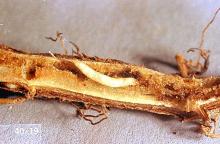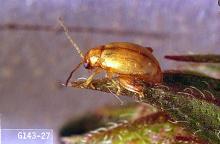Longitarsus waterhousei
Pest description and crop damage Adults are small, 2mm long, pale brown to brownish-yellow flea beetles feed on mint foliage producing "shot-holed leaves." These usually are noticed first in late June, July. The main damage is by the larvae, also only 3mm long, which feed on and severely damage roots in late April, May, and June.
Biology and life history Eggs overwinter in the soil and hatch from early April through May. Larvae feed on roots and tunnel rhizomes through early June. Adults emerge in late June and July and feed, mate, and deposit eggs in or on the soil in July and August. There is a 2- to 3-week pre-ovipositional phase before females lay eggs. Insecticides applied to control adults should be used at this time to prevent larval infestations. There is one generation per year.
Scouting and thresholds Larvae can be seen tunneling in roots and underground stems in late April, May, and June. Screen and inspect roots and associated soil for larvae and damage. Inspect leaves for adult "shot-holing" from late June through early August. Use a sweep net to collect adults in early morning hours when beetles easily are swept from foliage (below 60°F).
Infestations usually begin at field margins. Inspect the entire field for larval and adult damage. Generally, adult populations are spotty and localized. Because of the potential for damage, they usually are treated when detected (early July).
For adult control, the idea is to apply an insecticide after most adults have emerged but before females have commenced egg laying.
Management-cultural control
This insect is moved from field to field primarily in infested rootstock, usually as eggs in the soil. Plant rootstock from fields free of this pest.
Management-chemical control
These are directed at the adult stage.
- azadirachtin (AzaMax) at 0.012 to 0.044 lb ai/A. PHI 0 days. REI 4 hr. Some formulations are OMRI-listed for organic use.
- chlorantraniliprole/thiamethoxam (Voliam Flexi) at 0.05 to 0.1 lb ai/A. PHI 7 days. REI 12 hr. Retreatment interval 14 days. Do not exceed 15 oz/A Voliam Flexi or 0.188 lb ai/A of thiamethoxam or 0.2 lb ai/A of chlorantraniliprole per season. Apply in at least 10 gal water/A (ground) or 5 gal water/A (aerial). Do not use an adjuvant.
- malathion (Gowan Malathion 8) at 0.94 lb ai/A. PHI 7 days. REI 12 hr. Retreatment interval 7 days. Limit 3 applications and 2.28 lb ai/A per year. Apply malathion as a full coverage spray after adults emerge, usually in early July. Time sprays for early morning hours when beetles are on foliage and easiest to kill.
- methomyl (Lannate SP) at 0.68 to 0.9 lb ai/A. PHI 14 days. REI 48 hr. Do not apply more than 1.8 lb ai/A per growing season or 4 applications. Apply Lannate as a full coverage spray after adults emerge, usually in early July. Restricted use pesticide.
- thiamethoxam (Actara) at 0.023 to 0.047 lb ai/A. PHI 7 days. REI 12 hr. Retreatment interval 14 days. Do not apply more than 0.188 lb ai/a per season. Do not use less than 10 GPA for ground applications or 5 GPA for aerial applications.



